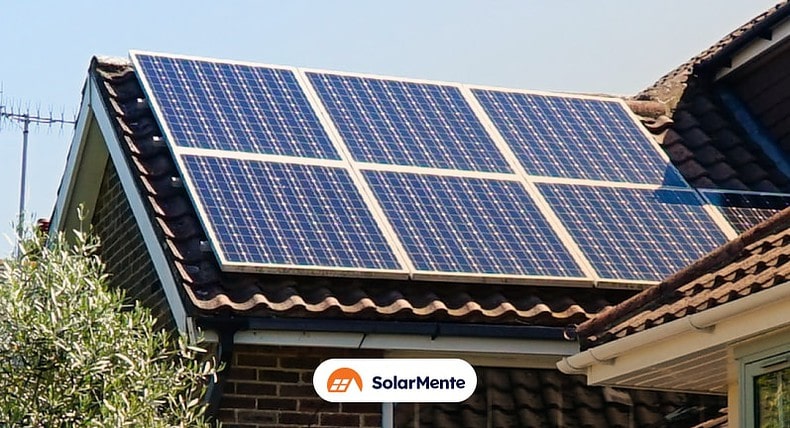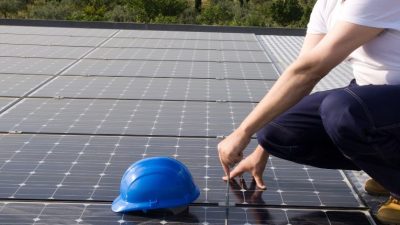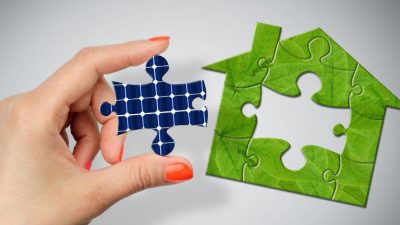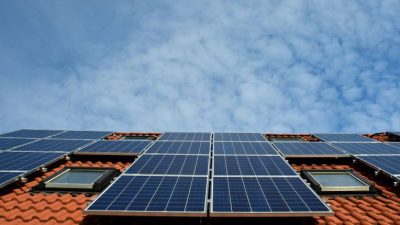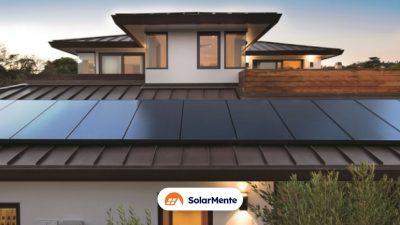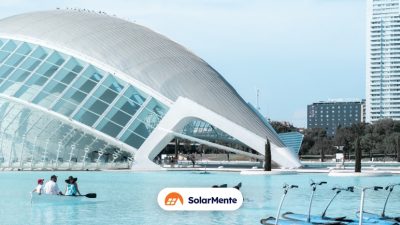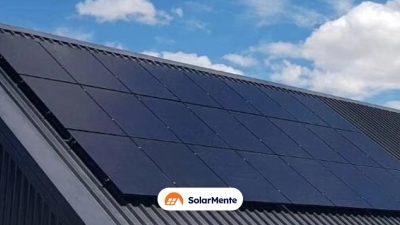Knowing how much energy a solar panel produces is important for the consumption of a home.
Because if it does not generate the necessary amount for our home, the estimated savings will decrease and the cost of the electricity bill will be higher than expected.
But making the calculation requires knowing certain variables such as the hours of sunshine, the type of panel or the orientation of the roof, among others.
And we are not going to go into complex terms or complicated calculations, but we want you to get an idea of how many kWh your solar panels can produce, because this will have an impact on the energy consumed and the final savings.
We will also tell you some tips to check that your solar panels are working at maximum performance.
Shall we start?
But before we get into the formulas, what is a kWh?
First we are going to explain the term kWh in case you are not entirely clear about it.
To do so, let’s define what a watt and a kilowatt are.
Both terms refer to the rate at which a component consumes energy. That is, 1 kW is equivalent to 1,000 W.
Let us explain it better with an example.
An 800 W washing machine will consume energy at a rate of 800 W per hour.
As for solar panels, the power is measured in watt-peak (Wp), i.e. the maximum power they offer.
That said, let’s clarify what a kilowatt-hour (kWh) is.
It is the unit of measurement that reflects the actual consumption of an electrical appliance in an hour, i.e. it informs us of the energy consumed in a set period.
And the equivalence is the same as in the previous case, i.e. 1 kWh is equal to 1,000 kW.
Taking the previous example, if the 800 W washing machine is running for two hours, the result is as follows:
800 W x 2 hours = 1,600 kW = 1.6 kWh.
It is common to confuse power with electrical energy. If you want more information, this article explains the differences between electrical power and energy.
Now, let’s move on to the calculation of the energy produced by a solar panel.
How much energy does a solar panel generate?
If we want to know how many kWh a solar panel produces, we must consider the following aspects:
-
Efficiency of the system
-
Number of hours of direct sunshine
In principle, multiplying the power and the number of hours of light received would be enough to know the total kWh in a given period.
But what actually happens?
We tell you.
Power is usually measured under standard conditions, i.e. it does not take into account climate or system losses.
For this very reason, if we want to be more accurate, it is important to take into account the efficiency of the photovoltaic installation.
Remember that in the process of transforming current energy into alternating energy (that which we can consume), around 5% of energy can be lost. However, this figure varies depending on the manufacturer.
Having clarified this, let’s see how much energy a solar panel produces with the following formula:
(Power (W) of the panel X Output X Sunshine hours) / 1,000 = kWh/day.
Let’s look at an example.
Imagine we have the following data:
-
Nominal power of 350 W
-
Efficiency of 95%
-
6 hours of sunlight
The calculation would be as follows:
Energy produced = (350W X 0,95 X 6) / 1.000 = 1,99 kWh/day
The 1,99 kWh/day shows you the energy that the solar panel provides you with during a day with 6 hours of direct sunlight.
But the truth is that not all times of the year have the same hours of sunshine.
Solar panels in winter do not produce the same energy as in summer, although that does not mean that they are not profitable. If you are looking for more information, this publication gives you all the details.
However, let’s assume that the same conditions are maintained throughout the month and the year for the sake of illustration. The data would be as follows:
-
Energy produced per month = 59,7 kWh
-
Energy during 1 year = 726 kWh
And how much energy does a complete installation produce?
It is as simple as applying the above formula, but taking into account the power of all the photovoltaic modules.
Let’s have a look at it.
In this case, you have:
-
9 panels with 350 W each = 3.150 W
-
95% efficiency
-
6 hours of sunlight
The calculation would be as follows:
Energy produced = (3.150 W x 0,95 x 6) / 1.000 = 17,95 kWh/day
How much energy does it generate per year? Multiply this figure by 365 days and it will give us a total of 6,552 kWh.
Factors determining how much energy a solar panel produces
To get the most out of your investment and maximise the output of your solar panels, you need to consider the following factors that affect the energy generated:
Solar panel type and materials
There are different types of solar panels on the market depending on the material and technology used.
This means that each of them has a specific efficiency and performance level.
We can distinguish between three types: monocrystalline, polycrystalline and thin-film. However, for residential use, monocrystalline technology is the most commonly used because of its efficiency, around 3-5% higher than polycrystalline panels.
It is true that the cost is higher, but they perform better when irradiation is not high, producing more energy in the first and last hours of the day.
In any case, solar panels on the market today have a high yield and their efficiency is in the range of 20 to 23%.
And what awaits us in the future.
Because a group of engineers at the National Renewable Energy Laboratory(NREL), have set to work and have achieved an efficiency of almost 40% in solar cells.
In contrast, thin-film modules have a lower efficiency and are usually intended for use in caravans, for example.
Hours of sunshine
We can say that the hours of sunshine received is a key factor in calculating how much energy a solar panel produces.
The more hours of sunshine the self-consumption installation receives, the more energy the panels absorb and, therefore, the more energy we can consume for the home.
But be careful, because receiving direct light is not the same as receiving diffuse or reflected light.
Although clouds allow sunlight to pass through, direct radiation provides greater absorption and, consequently, energy production.
For more details, you can access the European Union’s photovoltaic geographic information system. This is a tool that provides data on solar production in a specific geographical area.
Orientation, tilt and other parameters
The orientation and tilt of the solar panels is another factor that has an impact on energy production.
Keep in mind that if the panels are not oriented properly and the area is full of shadows, it is an obstacle to producing electricity, especially with the use of string inverters. If one panel is affected, the output of the remaining modules will be reduced at the same time.
In the same vein, it is important to maintain solar panels.
Sometimes we think of this as installing the system and that’s it, but it needs regular cleaning.
Because if dirt accumulates, such as dust or bird droppings, performance can drop by up to 40 per cent in the worst circumstances.
Therefore, two or three cleanings will be sufficient to avoid this problem.
Efficiency
The efficiency of solar panels is the ability to convert sunlight into electricity.
In other words, it is the factor that confirms the amount of available energy that is converted into electricity.
Because we have to take into account that not all the sunlight absorbed by the modules is converted into electrical energy for our domestic consumption.
The higher the efficiency, the more electricity available for the household.
As we have already mentioned in previous sections, most solar panels on the market are between 20 and 23%.
Climate
The climate also has a lot to say here.
The weather conditions in a geographical area have a positive or negative influence on the performance of solar panels.
Places that receive more hours of sunshine per year with clear skies will be able to improve the performance.
And here we would like to emphasise the following point:
Extreme temperatures are not favourable in energy production, neither too hot nor too cold. They are detrimental and affect the performance of the system.
We have to differentiate between heat and hours of sunshine received. Because the optimum temperature of a panel is around 25 ºC.
Caution should also be exercised in cold weather, especially in the event of heavy snowfall. The solar system should be cleaned as soon as possible so that it does not freeze and the layers limit the sun’s rays.
How to check that your solar panels are producing maximum power
How can I confirm that my panels are working at full capacity?
Well, here we are going to give you a few simple tricks to check if they are producing the energy you need.
And these are:
-
Monitor your system. There is no better way than to check on the application and make sure everything is running smoothly. Every manufacturer includes its control system to track energy production in real time. Check that the parameters are in order.
-
Keep an eye on the electricity bill. Compare the cost before and after the self-consumption installation. If you notice a significant reduction in savings (about half), the system is working properly.
-
Look at the state of your roof. We are not saying that you should climb on the roof (far from it), but if you have easy access to see, check if there are any flaws, cracks or excessive dirt that could be detrimental to energy collection.
-
Schedule an annual inspection by professionals. To be certain that everything is in order, it’s a good idea to have check-ups to verify that the panels and wiring are in good order, as well as the performance. With our solar subscription model (panel rental), this is not an extra cost, but is included in the monthly fee.
It’s time to define the power output of your solar panels.
Now that you know more information about how much energy a solar panel produces, it is time to define the power you will need for your installation to generate enough energy for your home.
What does this depend on?
Well, it basically depends on the following points:
-
Consumption of the house
-
Structure and location of the roof
-
Size of the photovoltaic system required
And for this it is important to make a preliminary study of the location by solar energy professionals.
That is why we analyse each individual case and take care of everything.
We give a personalised and adapted budget according to the energy needs of each client.
This is the way to go if your goal is to reduce your electricity bill by at least 50% while taking care of the environment.
If you want us to help you too, enter here and calculate how much you can save in a month with your self-consumption system.
See you inside!

